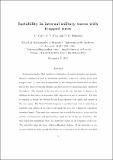Files in this item
Instability in internal solitary waves with trapped cores
Item metadata
| dc.contributor.author | Carr, Magda | |
| dc.contributor.author | King, Stuart Edward | |
| dc.contributor.author | Dritschel, David Gerard | |
| dc.date.accessioned | 2013-03-15T14:31:06Z | |
| dc.date.available | 2013-03-15T14:31:06Z | |
| dc.date.issued | 2012-01 | |
| dc.identifier | 17779963 | |
| dc.identifier | 577c5194-26c2-449e-ae1a-639c38c4e28a | |
| dc.identifier | 84856437578 | |
| dc.identifier.citation | Carr , M , King , S E & Dritschel , D G 2012 , ' Instability in internal solitary waves with trapped cores ' , Physics of Fluids , vol. 24 , no. 1 , 016601 . https://doi.org/10.1063/1.3673612 | en |
| dc.identifier.issn | 1070-6631 | |
| dc.identifier.other | ORCID: /0000-0001-6489-3395/work/64697826 | |
| dc.identifier.uri | https://hdl.handle.net/10023/3397 | |
| dc.description.abstract | A numerical method that employs a combination of contour advection and pseudo-spectral techniques is used to investigate instability in internal solitary waves with trapped cores. A three-layer configuration for the background stratification in which the top two layers are linearly stratified and the lower layer is homogeneous is considered throughout. The strength of the stratification in the very top layer is chosen to be sufficient so that waves of depression with trapped cores can be generated. The flow is assumed to satisfy the Dubriel-Jacotin-Long equation both inside and outside of the core region. The Brunt-Vaisala frequency is modelled such that it varies from a constant value outside of the core to zero inside the core over a sharp but continuous transition length. This results in a stagnant core in which the vorticity is zero and the density is homogeneous and approximately equal to that at the core boundary. The time dependent simulations show that instability occurs on the boundary of the core. The instability takes the form of Kelvin-Helmholtz billows. If the instability in the vorticity field is energetic enough, disturbance in the buoyancy field is also seen and fluid exchange takes place across the core boundary. Occurrence of the Kelvin-Helmholtz billows is attributed to the sharp change in the vorticity field at the boundary between the core and the pycnocline. The numerical scheme is not limited by small Richardson number unlike the other alternatives currently available in the literature which appear to be. | |
| dc.format.extent | 815490 | |
| dc.language.iso | eng | |
| dc.relation.ispartof | Physics of Fluids | en |
| dc.rights | This is the author's version of this article. The published version © 2012 American Institute of Physics is available at http://link.aip.org/link/doi/10.1063/1.3673612 | en |
| dc.subject | Flow instability | en |
| dc.subject | Solitons | en |
| dc.subject | Stratified flow | en |
| dc.subject | Vortices | en |
| dc.subject | QA Mathematics | en |
| dc.subject.lcc | QA | en |
| dc.title | Instability in internal solitary waves with trapped cores | en |
| dc.type | Journal article | en |
| dc.contributor.sponsor | EPSRC | en |
| dc.contributor.institution | University of St Andrews.Applied Mathematics | en |
| dc.contributor.institution | University of St Andrews.Scottish Oceans Institute | en |
| dc.contributor.institution | University of St Andrews.Marine Alliance for Science & Technology Scotland | en |
| dc.identifier.doi | 10.1063/1.3673612 | |
| dc.description.status | Peer reviewed | en |
| dc.identifier.grantnumber | EP/F030622/1 | en |
This item appears in the following Collection(s)
Items in the St Andrews Research Repository are protected by copyright, with all rights reserved, unless otherwise indicated.

